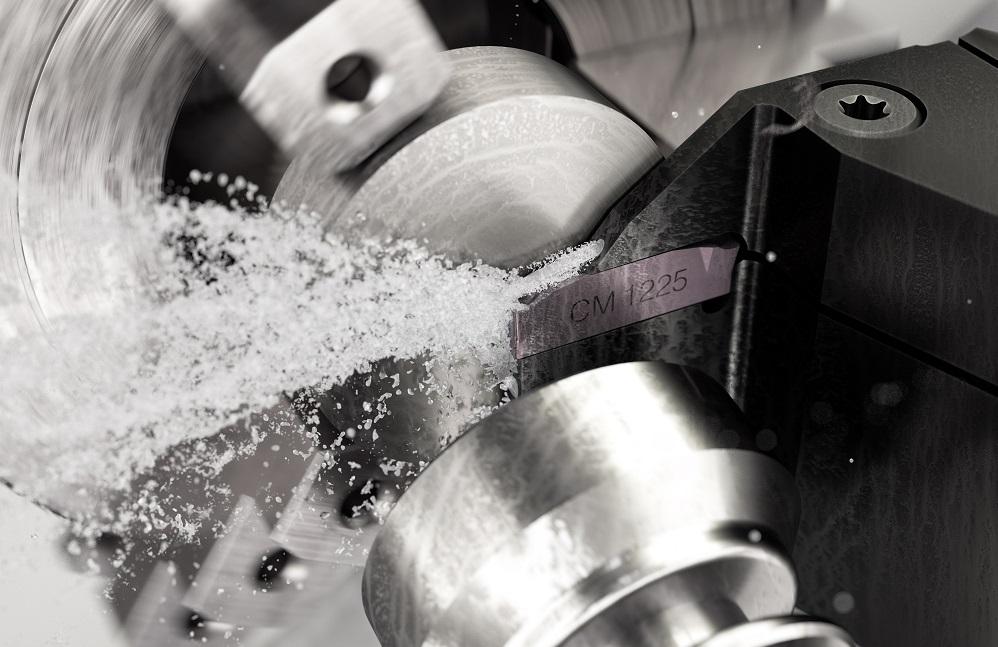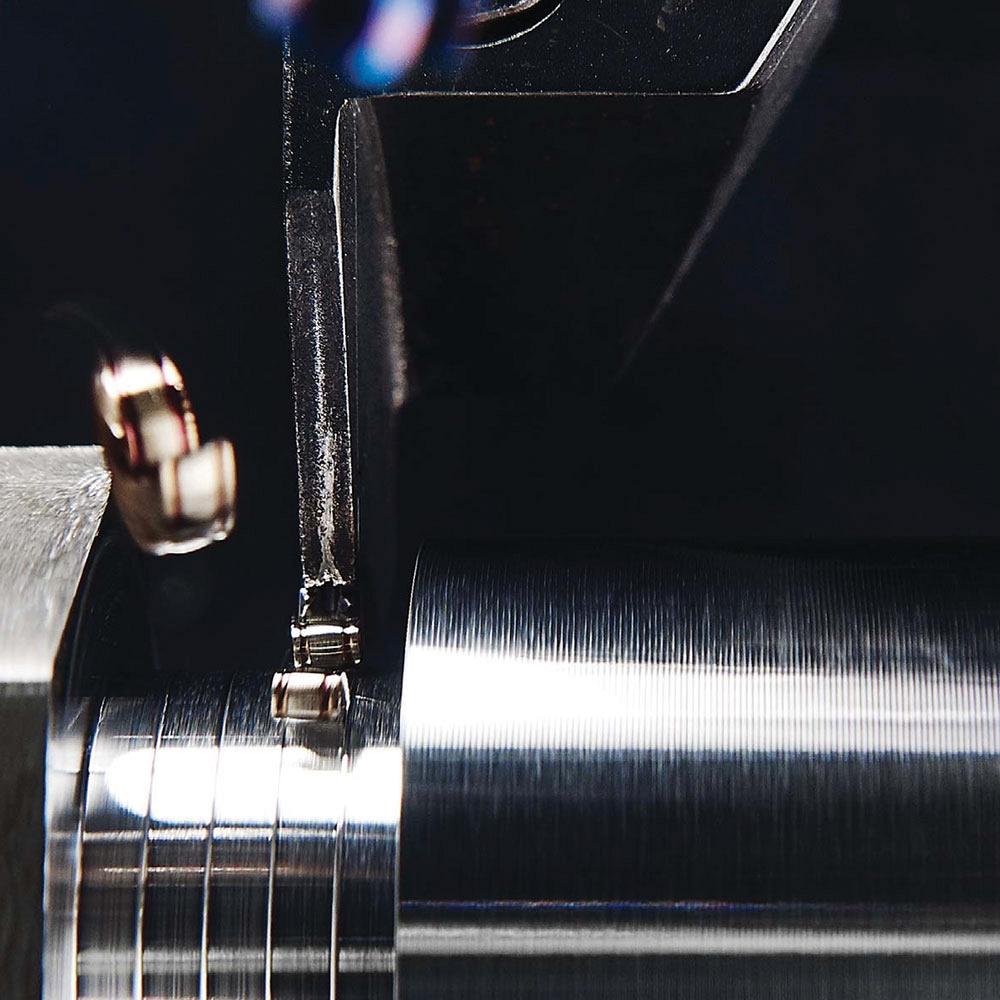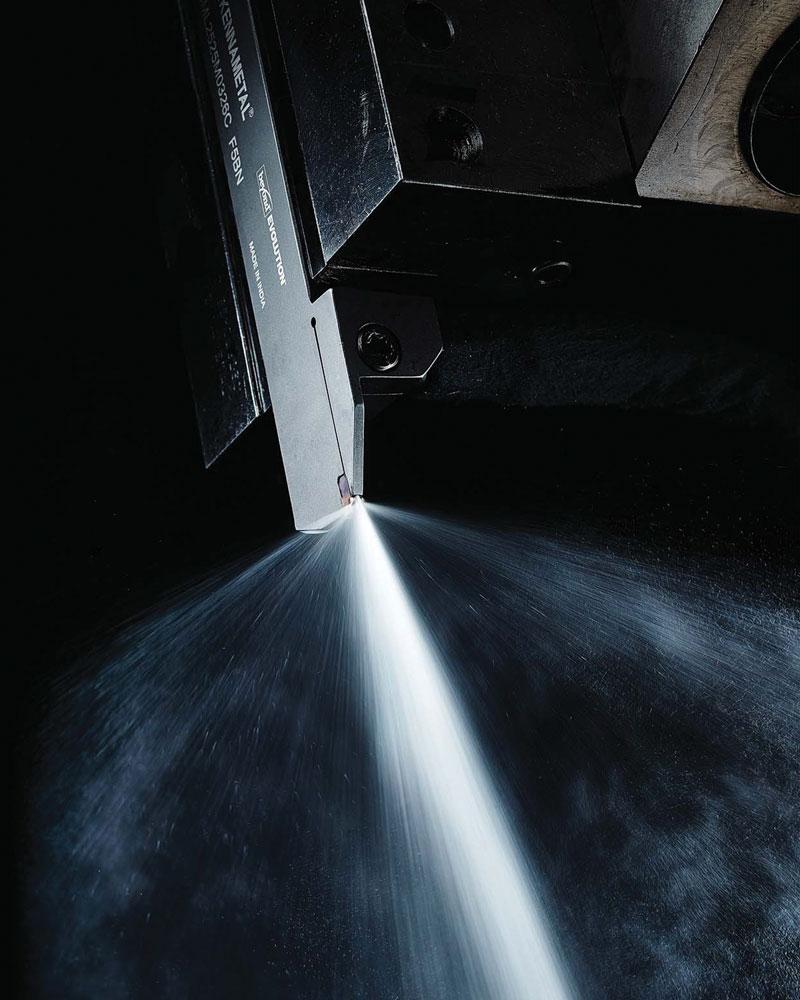Associate Editor
- FMA
- The Fabricator
- FABTECH
- Canadian Metalworking
Don’t break the blade
Expert advice to ensure parting-off success
- By Lindsay Luminoso
- January 15, 2024
- Article
- Cutting Tools

According to Keith Brake, you should choose the shortest blade possible for the application to minimize walking or flexing within the blade, which increases the risk of breakage. Sandvik Coromant
Shakespeare once wrote, “Parting is such sweet sorrow.” While he undoubtedly was referring to the separation of his characters, his words ring true for many who struggle with parting-off operations. What is it about parting off that makes it so difficult? There are numerous things that can go wrong during parting-off operations, including blade breakage. Parting-off blades can be expensive and the components that they are used to part off, even more so. The last thing any operator wants is a broken blade leading to a scrapped part.
Nine considerations can help ensure successful parting-off operations.
1. Material Properties
Material type will dictate many aspects of parting-off operations. For example, softer steels and non-ferrous materials like aluminum will require less cutting force than harder materials.
“When you get into the stainless steels, high-temp alloys, or INCONELs, you want to start thinking about the strength of the tooling because significantly more cutting forces will be involved,” said Greg Sage, regional product manager – turning, Americas, at Kennametal, Pittsburgh. “You need to be mindful of the material and all that follows.”
2. Rigid Setup
Proper workholding and fixturing can sometimes be overlooked as a consideration for parting-off success.
“A rigid setup is so important,” said Sage. “The rigidity of the spindle and clamping will directly affect operational success. The weaker the setup, the harder it will be for the tool to perform, and the more vibration that will be introduced and transmitted into the workpiece and blade, leading to both blade breakage and scrapping the part.”
3. Reinforced Toolholders
Along with a strong workholding setup, strong toolholding also is beneficial.
“Reinforced toolholders have extra steel built into the blade area that is actually swept in the same shape as the diameter of the bar,” said Sage. “That way, the blade has as much reinforcement as possible.”
However, a reinforced toolholder will have application limitations, meaning that it can only be used in 3.2 in. dia. or less. Once you go above that, either single-ended or double-ended cutoff blades are designed for larger-diameter parting-off operations.
4. Blade Length
Start with the diameter that you're going to be parting off and choose a blade that is going to be rigid enough for the amount of stick-out that you need.

A rigid setup and a reinforced toolholder will help provide functional stability and reduce vibration, making parting-off operations more successful. Kennametal
“You want to have the shortest blade that you can have that will successfully part-off the bar,” said Keith Brake, turning product manager for the Americas, Sandvik Coromant, Mississauga, Ont. “Shallow parting off inherently has a shorter stick-out of the tool, meaning you can be more aggressive with the cut. Deeper parting-off applications, by nature, will require a stretched-out blade.”
The longer the blade, the more it is affected by cutting parameters, and the less aggressive you can be in the cut.
“Blade life is significantly impacted by movement of the blade during cut,” said Brake. “The general rule of a thumb is to choose a blade as short as possible for the application to minimize that walking or flexing within the blade, risking breakage.”
5. Insert Width
The larger the insert width, the more robust it will be, offering more strength as you go into the cut.
“There is a balance needed between the width of the insert and the material scrapped,” said Sage. “Obviously, the larger the insert width, the more material will be wasted. It’s important to get as much usage out of the material, but at the same time, you want to ensure that the insert is robust enough to handle the parting-off operation.”
In softer materials, it is easier to get away with using a small, narrow-width blade and insert. In the harder materials, choosing an insert and blade that is even marginally wider will add rigidity and strength.
“Choose the narrowest insert that facilitates your application to save stock without sacrificing setup and process control,” said Brake.
6. Neutral or Handed Inserts
Parting-off operations almost always leave a pip because you almost never can truly part off the bar completely.
“You can determine where you want to leave the pip by choosing a handed insert,” said Brake. “A handed insert is slanted, and the slant of the insert determines which portion, left or right hand, will come through the material first. Typically, you want to cut through the material first and have the cleanest face on the part that's going to be passed into the subspindle or the part that's going to be used rather than the remnant. A handed insert always makes sense if you're dropping off a finished component.”
The benefit of working with a neutral insert is that it tends to be more robust and allows for more cutting force to be applied. A neutral insert passes neutrally, or flat, through the material across the centre rotation in a parallel plane.

According to Keith Brake, you should choose the shortest blade possible for the application to minimize walking or flexing within the blade, which increases the risk of breakage. Sandvik Coromant
Choosing between a handed or neutral insert is really a matter of determining if the part can have a pip, where that pip should be located, the quality of the face, and what the setup can handle. A cutting edge that can check all the right boxes and still be robust enough to perform the operation is essential for success.
7. Coolant Control
Coolant-through capabilities will help clear chips out of the often tight cutting zones and cool the area where heat is being generated.
“This allows for more flexibility to optimize cutting parameters, which in turn allows you get the best chip control possible,” said Sage. “One of the biggest reasons why parting off can be so difficult is it often produces ribbon chips. The more we can get those chips under control, the less likely they are to jam up inside that groove that you're creating as you're cutting off.”
Ribbon chips stuck in the cutting zone put extra force on the blade and can cause it to break. Coolant allows you to make sure those parameters are optimized while still maintaining really good tool life.
8. Cutting Parameters
In today’s manufacturing environment, most people are concerned with production and throughput, but it also is important to focus on controllability.
“The biggest challenge is not utilizing parameters correctly,” said Sage. “Operators often feed way too fast or not fast enough. Also, with parting off, you're plunging straight down to the middle of that part, and as you get closer to the middle of that barstock, the surface footage decreases. Unless you are ramping up speed throughout the cut cycle or you've got a constant surface footage setting on your machine, the surface footage basically becomes zero the closer to centre you get.”
Make sure to utilize the programming on the machine to achieve the proper surface footage. Incorrect cutting parameters will put extra stress on the tooling, which can lead to breakage.
“For interrupted parting applications, operators can begin with a slow start, where you reduce the feed upon entry and then increase the feed once we have a consistent cut or continuous cut,” said Brake. “A lot of people fail to slow down the feed rate before they cross the centre of rotation, which also is important.”
Proper cut data will give operators the most optimal experience and the longest tool life for the setup.
In some situations, especially when it comes to poor surface finish and reduced tool life, an operator’s inclination is to slow down. But according to the experts, slower is not always better.

According to Greg Sage, one of the biggest reasons why parting off can be so difficult is it often produces ribbon chips. Coolant-through capabilities allow for more flexibility to optimize cutting parameters, which in turn allows you get the best chip control possible. Kennametal
“Today's carbide is designed to run high efficiency, which means when we slow down, it can have the reverse effect of what we would think we would have,” said Brake. “The biggest misconception that I would like to dispel is that we must feed slow.”
9. Y-Axis Parting Off
When possible, Y-axis parting off is the way to go. According to Brake, it is significantly more stable than X-axis parting off. If you have a turning centre with Y-axis capabilities or a multitasking machine, take advantage of it.
It tends to allow for more productive and reliable parting-off operations.
Associate Editor Lindsay Luminoso can be reached at lluminoso@fmamfg.org.
Kennametal, www.kennametal.com
Sandvik Coromant, www.sandvik.coromant.com
About the Author

Lindsay Luminoso
1154 Warden Avenue
Toronto, M1R 0A1 Canada
Lindsay Luminoso, associate editor, contributes to both Canadian Metalworking and Canadian Fabricating & Welding. She worked as an associate editor/web editor, at Canadian Metalworking from 2014-2016 and was most recently an associate editor at Design Engineering.
Luminoso has a bachelor of arts from Carleton University, a bachelor of education from Ottawa University, and a graduate certificate in book, magazine, and digital publishing from Centennial College.
Related Companies
subscribe now


Keep up to date with the latest news, events, and technology for all things metal from our pair of monthly magazines written specifically for Canadian manufacturers!
Start Your Free Subscription- Trending Articles
Automating additive manufacturing

Sustainability Analyzer Tool helps users measure and reduce carbon footprint

CTMA launches another round of Career-Ready program

Sandvik Coromant hosts workforce development event empowering young women in manufacturing

GF Machining Solutions names managing director and head of market region North and Central Americas

- Industry Events
MME Winnipeg
- April 30, 2024
- Winnipeg, ON Canada
CTMA Economic Uncertainty: Helping You Navigate Windsor Seminar
- April 30, 2024
- Windsor, ON Canada
CTMA Economic Uncertainty: Helping You Navigate Kitchener Seminar
- May 2, 2024
- Kitchener, ON Canada
Automate 2024
- May 6 - 9, 2024
- Chicago, IL
ANCA Open House
- May 7 - 8, 2024
- Wixom, MI















